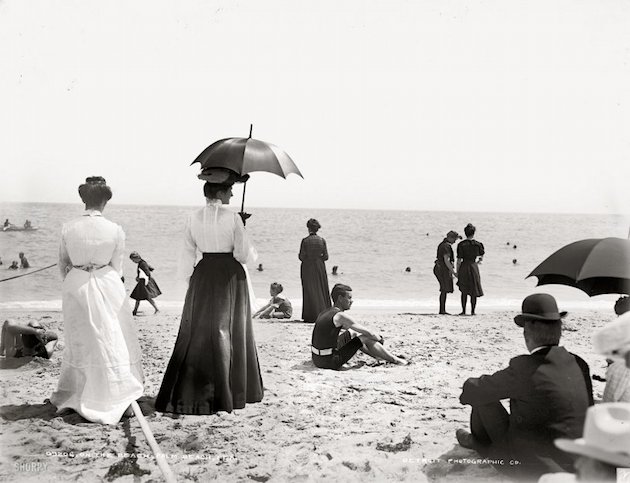
DPC ‘On the beach, Palm Beach’ 1905

New cases past 24 hours in:
• US + 21,608
• Brazil + 28,832
• Russia + 8,952
• India + 8,272
• Peru + 4,845
• Pakistan + 4,065

LOGICAL INCONSISTENCY DU JOUR
Someone said "if an old person dies of COVID, it's not a big deal because they could have died of someone else".
To be consistent, you must accept:
"If a someone kills an old person, it's not a big deal because they could have died of someone else".— Nassim Nicholas Taleb (@nntaleb) June 2, 2020
3)Do not disrupt the Silver rule: don't treat the older generation the way you don't want the next generation to treat you.
Civilization and group moral rectitude started with the Silver and Golden rules.
Geronticide is morally repulsive; only accepted in nouveau-riche societies.— Nassim Nicholas Taleb (@nntaleb) June 2, 2020

For some bizarre reason, it’s not easy to see a map or list of all the cities that have protests currently in any of the main papers or media outlets. I eventually found it.
It’s over 350 cities across the US that are protesting.
350. This shows the scale of issues & anger.
— Raoul Pal (@RaoulGMI) June 3, 2020

Number of cases seems extremely low at less than 80K vs well over 100K for the past week.
• Cases 6,474,289 (+ 79,973 from Saturday’s 6,394,316)
• Deaths 382,914 (+ 4,948 from Saturday’s 377,966)

From Worldometer yesterday evening -before their day’s close-:
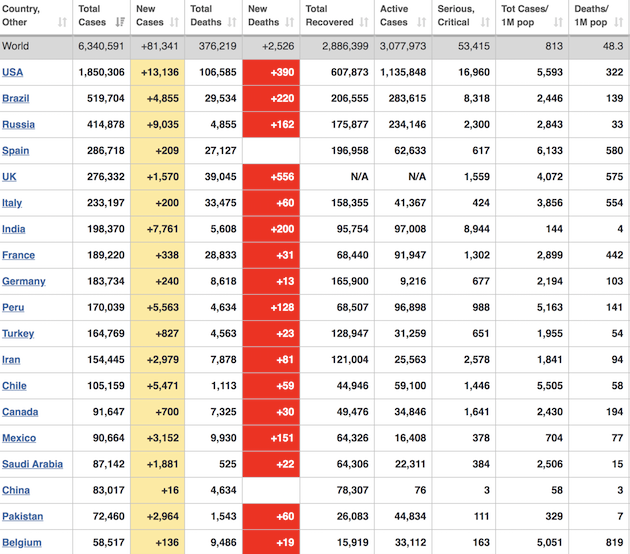
From Worldometer:
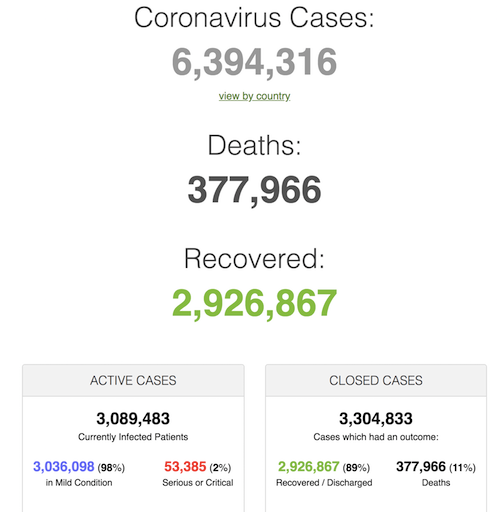
From COVID19Info.live:
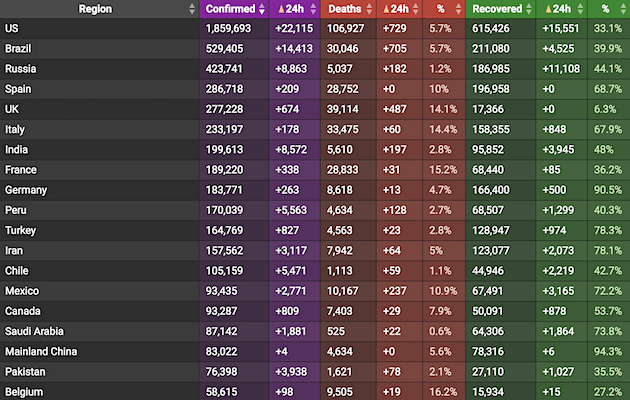

While 99% of the rest of the world stumbles on with no end in sight.
• New Zealand Could Return To Normal Life As Early As Next Week (R.)
New Zealand Prime Minister Jacinda Ardern said on Wednesday she could lift all social distancing measures to return the country to normal life, bar the international border closure, as early as next week. Ardern will decide on Monday whether the country is ready to shift to alert level 1, more than two months after she imposed a strict level 4 lockdown, shutting most businesses and forcing people to stay home, in response to the coronavirus pandemic. Arden said waiting until Monday would allow her to see if recent changes, like the removal of restrictions on the number of people in bars and at social gatherings, had led to a rise in cases. “If it hasn’t, then we will be in a good position to move,” she said during a televised news conference.
Under level 1 there is no requirement for physical distancing or limits on the number of people allowed in places like bars, clubs, churches, and sports venues, she said. However, there would be one major change from pre-pandemic normality, with no immediate plans to reopen New Zealand’s border. New Zealand recorded no new cases of coronavirus for a 12th consecutive day on Wednesday and has just one active case. Ardern’s decision to swiftly impose one of the harshest lockdowns in the world has been credited with constraining the spread of COVID-19 in New Zealand, which has reported a total of 1,504 cases and 22 deaths.

Nothing explains everything, but the angle remains interesting.
• Coronavirus May Be a Blood Vessel Disease, Which Explains Everything (M.)
In April, blood clots emerged as one of the many mysterious symptoms attributed to Covid-19, a disease that had initially been thought to largely affect the lungs in the form of pneumonia. Quickly after came reports of young people dying due to coronavirus-related strokes. Next it was Covid toes — painful red or purple digits. What do all of these symptoms have in common? An impairment in blood circulation. Add in the fact that 40% of deaths from Covid-19 are related to cardiovascular complications, and the disease starts to look like a vascular infection instead of a purely respiratory one. Months into the pandemic, there is now a growing body of evidence to support the theory that the novel coronavirus can infect blood vessels, which could explain not only the high prevalence of blood clots, strokes, and heart attacks, but also provide an answer for the diverse set of head-to-toe symptoms that have emerged.
“All these Covid-associated complications were a mystery. We see blood clotting, we see kidney damage, we see inflammation of the heart, we see stroke, we see encephalitis [swelling of the brain],” says William Li, MD, president of the Angiogenesis Foundation. “A whole myriad of seemingly unconnected phenomena that you do not normally see with SARS or H1N1 or, frankly, most infectious diseases.” “If you start to put all of the data together that’s emerging, it turns out that this virus is probably a vasculotropic virus, meaning that it affects the [blood vessels],” says Mandeep Mehra, MD, medical director of the Brigham and Women’s Hospital Heart and Vascular Center.
In a paper published in April in the scientific journal The Lancet, Mehra and a team of scientists discovered that the SARS-CoV-2 virus can infect the endothelial cells that line the inside of blood vessels. Endothelial cells protect the cardiovascular system, and they release proteins that influence everything from blood clotting to the immune response. In the paper, the scientists showed damage to endothelial cells in the lungs, heart, kidneys, liver, and intestines in people with Covid-19. “The concept that’s emerging is that this is not a respiratory illness alone, this is a respiratory illness to start with, but it is actually a vascular illness that kills people through its involvement of the vasculature,” says Mehra.
SARS-CoV-2 is thought to enter the body through ACE2 receptors present on the surface of cells that line the respiratory tract in the nose and throat. Once in the lungs, the virus appears to move from the alveoli, the air sacs in the lung, into the blood vessels, which are also rich in ACE2 receptors. “[The virus] enters the lung, it destroys the lung tissue, and people start coughing. The destruction of the lung tissue breaks open some blood vessels,” Mehra explains. “Then it starts to infect endothelial cell after endothelial cell, creates a local immune response, and inflames the endothelium.”

“The rolling seven-day average for new confirmed deaths per million people in Sweden is now nearly twice that of the US..”
• Charting Sweden’s Disastrous No-Lockdown Strategy (Ind.)
Sweden has taken the ignominious title of the country with the world’s highest death rate from Covid-19. The title, which was was briefly held by the UK late last month, comes after Swedish officials decided to ignore the lockdown advice of countless health experts and kept the country largely open during the pandemic. The number of deaths per capita in Sweden is now more than four-times that of its Nordic neighbours. And while its death toll of around 4,500 is a fraction of other badly affected countries like the US (105,000) and the UK (38,000), it is the death rate that reveals the true impact of Sweden’s no-lockdown approach. The rolling seven-day average for new confirmed deaths per million people in Sweden is now nearly twice that of the US, and more than five-times that of France, which had the highest death rate in the world in April.
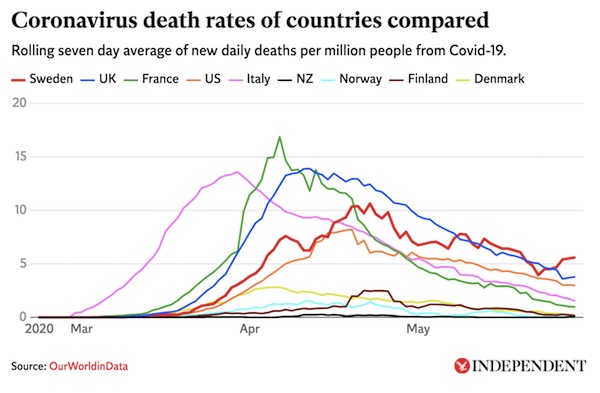
France imposed a strict lockdown, similar to those of Italy and Spain, in an attempt to contain severe outbreaks of the deadly virus. These lockdowns have proven to be an extremely effective strategy in the fight against coronavirus, with death rates dropping drastically in all of the countries that imposed them. Countries that pre-empted large-scale outbreaks with early lockdowns, such as New Zealand, appear to have almost entirely eliminated the virus.
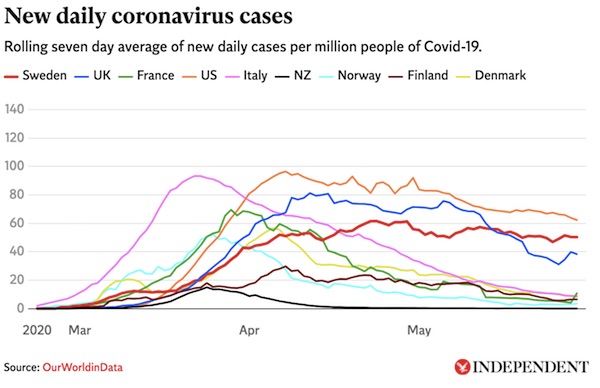
Yet while social distancing, PPE advice and other containment measures have helped slow the spread in Sweden, a lack of lockdown means the country’s infection rate shows no sign of falling. When Sweden is compared to other Nordic countries, the scale of the country’s coronavirus crisis seems even more pronounced.
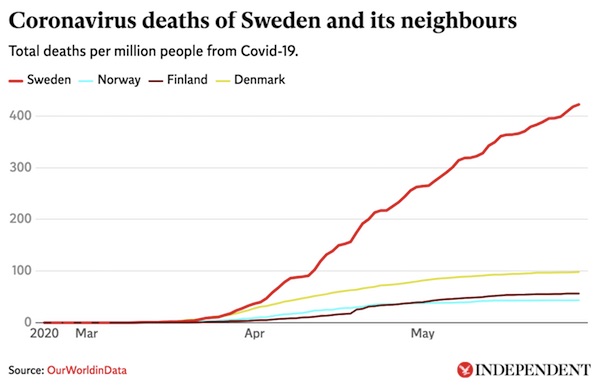
Sweden’s hope has been to achieve herd immunity, whereby enough of the population has been infected that coronavirus can no longer spread widely. Yet studies in May suggest that Sweden is nowhere near the threshold needed to realise this. Experts claim that at least 60 per cent of the population would need to have Covid-19 antibodies before herd immunity is reached. The government had hoped for 20 per cent immunity by the end of May, but instead only 7.3 per cent have it. This is lower than most countries that enforced lockdowns, including the UK and US, yet with still no lockdown in place, the full impact for Sweden may still a long way from being realised.
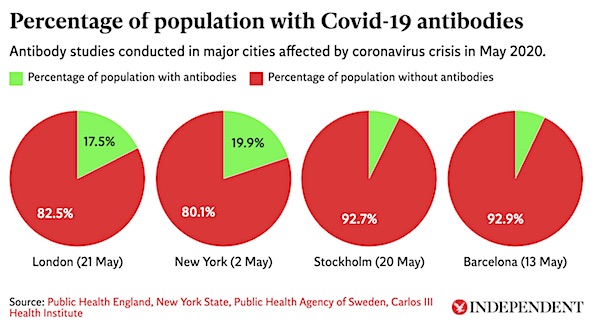

Rockin’ on.
• Brazil Sets Another Record For Daily Coronavirus Deaths (R.)
Brazil registered another record number of novel coronavirus deaths over the last 24 hours, the health ministry said on Tuesday evening, as the pandemic in Latin America’s largest country shows no signs of slowing down. The nation registered 28,936 additional cases of the novel coronavirus, the ministry said, and 1,262 deaths. There are now 555,383 total confirmed coronavirus cases in Brazil and 31,199 coronavirus deaths. The fresh record comes as some Brazilian leaders, including right-wing President Jair Bolsonaro, continue to belittle the virus, warning that the economic fallout from quarantine measures will be worse than the virus itself.
“We lament all deaths, but it’s everyone’s destiny,” Bolsonaro said in front of the presidential residence in Brasilia earlier on Tuesday. Even in states and cities where leaders had previously instituted lockdown orders, authorities have been rapidly loosening restrictions in recent days, despite the number of daily new cases continuing to grow in most regions.

I don’t get why they let them in in the first place. Qatar entered the top 20 of most cases/infections over the past few days, with over 60,000 cases. Thing is, only 2.8 million people live there. For the US, with 117x more people, that would come down to over 7 million cases. Granted, Qatar reports only 43 total deaths. But how credible is that?
• Greece Suspends Qatar Flights After 12 On One Plane Test Positive (K.)
Greece on Tuesday announced they were suspending flights to and from Qatar until mid-June, after 12 out of 91 passengers in a Qatar Airways flight that landed in Athens on Monday tested positive for the coronavirus. Nine of the infected passengers are Pakistani nationals, coming from the city of Gujrat, who have a Greek residence permit, two are Greek nationals coming from Australia and one person is a Japanese national and member of a Greek-Japanese family, the General Secretariat for Civil Protection said in a press release.
All passengers in the flight from Doha to Athens’ International Airport were tested and quarantined in hotels until they got their results back, in line with the current health protocols. Those infected will remain in the hotels for two weeks, while those who tested negative will have to stay for seven days as they are considered close high and low risk contacts, the authority said. Health officers will repeat the tests on the passengers who tested negative after a week.
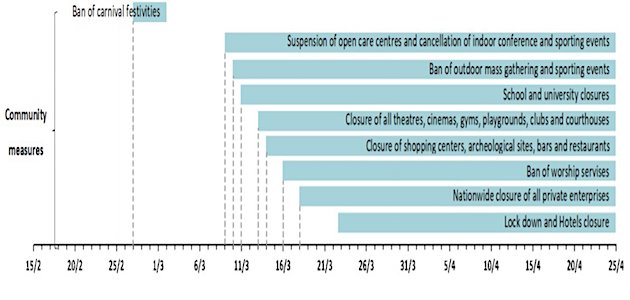
Timeline of Greece measures

As billions are thrown at everything everywhere, these people have an entire $90,000 in seed funding.
• Handheld High-Intensity UV Lamp Could Kill Coronavirus Once And For All (RT)
We may have a powerful new weapon in the war against Covid-19, as a scientific breakthrough has paved the way for personal, handheld devices that emit high-intensity ultraviolet (UV) light capable of killing the coronavirus. Chemical or UV exposure are the most common methods of sanitizing and disinfecting surfaces from bacteria and viruses. In the latter case, there need to be sufficiently high levels of UV radiation – 200 to 300 nanometers – to kill the unwanted bugs. Such devices do exist at present, but are prohibitively expensive, use discharge lamps that contain mercury, are bulky and short-lived, and require a large amount of power to function. Not exactly ideal for scaling up to rid the world of Covid-19.
However, using theoretical modeling of a range of materials, researchers at Penn State, the University of Minnesota and two Japanese universities believe they have found the holy grail of transparent conductors, which could allow for cheap, easy-to-produce LEDs that emit UV light at a high enough intensity to kill coronavirus. Computer, smartphone and lighting manufacturers have often grappled with finding transparent electrode materials that function in the visible light spectrum, let alone the ultraviolet spectrum. But the researchers have settled on a substance called strontium niobate as the potential game-changer material.
“While our first motivation in developing UV transparent conductors was to build an economic solution for water disinfection, we now realize that this breakthrough discovery potentially offers a solution to deactivate Covid-19 in aerosols that might be distributed in the HVAC (heating, ventilation and air conditioning) systems of buildings,” one of the researchers, Joseph Roth, a doctoral candidate in materials science and engineering at Penn State, explains. The researchers have secured $90,000 in seed funding to determine the ‘Goldilocks zone’ for UV intensity and exposure time to eradicate airborne viruses.
Which wavelengths of UV light are best for killing coronaviruses to disinfect surfaces?
An interdisciplinary team of Penn State researchers has been awarded seed-grant funding to find out. https://t.co/PO5kT77OuN pic.twitter.com/UQA5uBi7f6
— Penn State (@penn_state) June 2, 2020

The Lancet looks unprofessional.
• Lancet Issues Major Disclaimer On Anti-HCQ Study (ZH)
The Lancet has issued a major disclaimer regarding a study which prompted the World Health Organization to halt global trials of hydroxychloroquine (HCQ), an anti-Malaria drug currently being used around the world to treat COVID-19. As we noted last week, major data discrepancies have called the entire study into question – though the lead author says it does not change the study’s findings that patients who received HCQ died at higher rates and experienced more cardiac complications than without. Until the data has been audited, The Lancet issued the following “expression of concern” regarding the study.
“Important scientific questions have been raised about data reported in the paper by Mandeep Mehra et al,” reads the “expression of concern” from The Lancet. “Although an independent audit of the provenance and validity of the data has been commissioned by the authors not affiliated with Surgisphere and is ongoing, with results expected very shortly, we are issuing an Expression of Concern to alert readers to the fact that serious scientific questions have been brought to our attention. We will update this notice as soon as we have further information.” -The Lancet
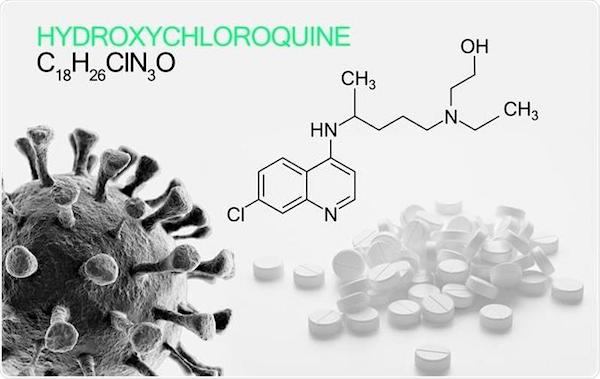
Of course, this is yet more evidence of the manufactured disinformation surrounding HCQ that Richard Moss, MD, (via AmericanThinker.com) exposes below… I took hydroxychloroquine for two years. A long time ago as a visiting cancer surgeon in Asia, in Thailand, Nepal, India, and Bangladesh. From 1987 to 1990. Malaria is rife there. I took it for prophylaxis, 400 milligrams once a week for two years. Never had any trouble. It was inexpensive and effective. [..] Chloroquine, the precursor of HCQ, was invented by Bayer in 1934. Hydroxychloroquine was developed during World War II as a safer, synthetic alternative and approved for medical use in the U.S. in 1955.
The World Health Organization considers it an essential medicine, among the safest and most effective medicines, a staple of any healthcare system. In 2017, US doctors prescribed it 5 million times, the 128th most commonly prescribed drug in the country. There have been hundreds of millions of prescriptions worldwide since its inception. It is one of the cheapest and best drugs in the world and has saved millions of lives. Doctors also prescribe it for Lupus and Rheumatoid arthritis patients who may consume it for their lifetimes with few or no ill effects. Then something happened to this wonder drug.
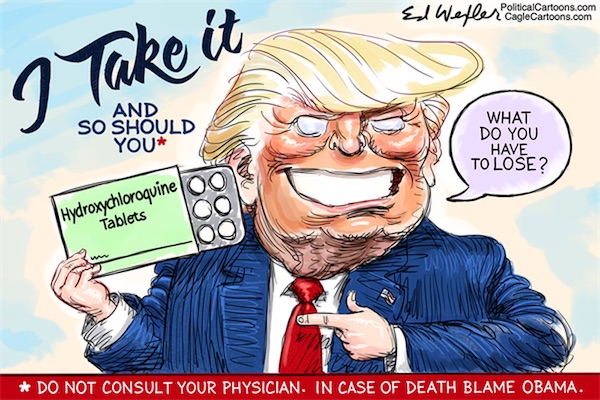
[..] It began when President Trump discussed it as a possible treatment for COVID-19 on March 19, 2020. The gates of hell burst forth on May 18 when Trump casually announced that he was taking it, prescribed by his physician. Attacks on Trump and this otherwise harmless little molecule poured in. The heretofore respected, commonly used, and highly effective medicinal became a major threat to life, a nefarious and wicked chemical that could alter critical heart rhythms, resulting in sudden cataclysmic death for unsuspecting innocents. Trump, more than irresponsible, was evil incarnate for daring to even mention it. While at it, the salivating media trotted out the canard about Trump’s nonrecommendation for injecting Clorox and Lysol or drinking fish-tank cleaner to combat COVID. It was Charlottesville all over again.
[..] the media agonized over, of all things, the prolongation of the now infamous “QT interval,” and the risk of sudden cardiac death. The FDA and NIH piled on, piously demanding randomized, controlled, double-blind studies before physicians prescribed HCQ. No one mentioned that the risk of cardiac arrest was far higher from watching the Superbowl. Nor did the media declare that HCQ and chloroquine have been used throughout the world for half a century, making them among the most widely prescribed drugs in history with not a single reported case of “arrhythmic death” according to the sainted WHO and the American College of Cardiology.

When the rich warn about society.
• The Great Unequalizer (El-Erian/Spence)
As parts of the United States begin to open up after months of coronavirus lockdown, hope is rising that some semblance of economic normalcy could be on the near-term horizon. That hope could still be dashed by lingering health, business, and consumer uncertainties, any of which could slow recovery. But for the least fortunate segments of the population, more economic pain is a virtual certainty. Far from the “great equalizer” that some initially dubbed the pandemic, COVID-19 has walloped the U.S. economy in a way that exacerbated inequalities in income, wealth, and opportunity. Absent a timely policy response, this negative trend could begin to reinforce itself, as one debilitating setback for the disadvantaged increases the odds of another.
The data are stark and alarming, and they will get worse before they get better. GDP is set to contract by 30 percent or more this quarter. More than 40 million workers, or roughly a quarter of the U.S. labor force, have filed jobless claims in the last three months. The unemployment rate is likely to approach—and could even exceed—the 25 percent record set during the Great Depression. And all this despite an enormous fiscal and monetary policy relief effort that cost nearly $6 trillion, or 28 percent of U.S. GDP in 2019. The distributional features of the job and income losses are even more concerning. According to a recent survey by the Federal Reserve, 39 percent of workers in households with annual incomes below $40,000 have been laid off or furloughed.
Women have been hit especially hard, as have minorities: of the 20.5 million jobs that vanished in April, 55 percent belonged to women, pushing the unemployment rate for women to 15 percent and the rate for African American women and Hispanic women to 16.4 percent and 20.2 percent, respectively. There is no question that the pandemic has been an unequal opportunity unemployer. Those whose jobs have withstood the shock of COVID-19 are disproportionately in relatively high-paying professions that can accommodate work-from-home arrangements. According to researchers at the University of Chicago’s Becker Friedman Institute, roughly one-third of U.S. jobs can be done remotely, but there are enormous discrepancies by sector—discrepancies that widen further when adjusted for earnings. Whereas 76 percent of (mostly well-paid) finance and insurance jobs can be done from home, for example, the same is true for just three percent of (mostly low-paid) food and service sector jobs.

The effects of the unequalizer.
• Food Bank Parcels For Scottish Children ‘At Record High’ (BBC)
Food banks in Scotland say they have recorded the largest ever increase in emergency food parcels going to children during the pandemic. The Trussell Trust – which runs 83% of the country’s network – reported total deliveries were up 47% in April compared to the same period in 2019. This included a 62% increase in parcels going to children. The trust is now calling for the government to give help to low-income families, including a £250 lump sum. It also wants an extension of cash payments for children eligible for free school meals until schools reopen in August. The Scottish government said it had committed £350m of additional funding “to support those most at risk”.
A spokesman said it was also supporting over 175,000 children with access to free school meals. More than 100 organisations have signed up to a coalition urging the Scottish and UK governments to help “as widespread concern mounts for children’s wellbeing”. The group includes the Trussell Trust, the / Independent Food Aid Network (IFAN) in Scotland and the Joseph Rowntree Foundation (JRF). They want the UK government to introduce a/ temporary/ Coronavirus Emergency Income Support Scheme. The charities say this would “ensure/ everyone has/ enough money in their pocket for essentials during this crisis”.

There was never a reason for the FBI to investigate Flynn. When they did anyway, they found nothing. And still here we are 40-odd months later, and he’s still not been cleared. People are going to pay for this.
• What The Flynn Transcripts Do Not Contain: A Crime (Turley)
“Remember … Ambassador, you’re not talking to a diplomat, you’re talking to a soldier.” When President Trump’s incoming national security adviser, Michael Flynn, said those words to then-Russian Ambassador Sergey Kislyak, he also spoke to American intelligence agents listening in on the call. For three years, congressional Democrats have assured us Flynn’s calls to Kislyak were so disturbing that they set off alarms in the closing days of the Obama administration. They were right. The newly released transcripts of Flynn’s calls are deeply disturbing — not for their evidence of criminality or collusion but for the total absence of such evidence. The transcripts, declassified Friday, strongly support new investigations by both the Justice Department and by Congress, starting with next week’s Senate testimony by former Deputy Attorney General Rod Rosenstein.
It turns out Flynn’s calls are not just predictable but even commendable at points. When the Obama administration hit the Russians with sanctions just before leaving office, the incoming Trump administration sought to avoid a major conflict at the very start of its term. Flynn asked the Russian to focus on “common enemies” in order to seek cooperation in the Middle East. The calls covered a variety of issues, including the sanctions. What was not discussed was any quid pro quo or anything untoward or unlawful. Flynn stated what was already known to be Trump policy in seeking a new path with Russia. Flynn did not offer to remove sanctions but, rather, encouraged the Russians to respond in a reciprocal, commensurate manner if they felt they had to respond.
The calls, and Flynn’s identity, were leaked by as many as nine officials as the Obama administration left office — a serious federal crime, given their classified status. The most chilling aspect of the transcripts, however, is the lack of anything chilling in the calls themselves. Flynn is direct with Kislyak in trying to tone down the rhetoric and avoid retaliatory moves. He told Kislyak, “l am a very practical guy, and it’s about solutions. It’s about very practical solutions that we’re — that we need to come up with here.” Flynn said he understood the Russians might wish to retaliate for the Obama sanctions but encouraged them not to escalate the conflict just as the Trump administration took office.
https://twitter.com/i/status/1268006146423623683

Lindsey Graham has a reputation of scaring away from major questions. But he won’t be able to stop this anymore.
• The 10 Most Important Questions For Rod Rosenstein (Solomon)
Two years ago, then-Deputy Attorney General Rod Rosenstein chafed when asked whether congressional Republicans might have legitimate reason to suspect the factual underpinnings of the Foreign Intelligence Surveillance Act warrants that targeted Trump campaign adviser Carter Page in the Russia probe. Seeming a bit perturbed, Rosenstein launched into a mini-lecture on how much care and work went into FISA applications at the FBI and Justice Department. “There’s a lot of talk about FISA applications. Many people I’ve seen talk about it seem not to recognize that a FISA application is actually a warrant, just like a search warrant. In order to get a FISA warrant, you need an affidavit signed by a career law enforcement officer who swears the information is true … And if it is wrong, that person is going to face consequences,” Rosenstein asserted.
[..] On Wednesday, when he appears before the Senate Judiciary Committee, Rosenstein is likely to strike a humbler tone in the face of overwhelming evidence that the FBI-executed FISAs have been chronically flawed, including in the Russia case he supervised. “Even the best law enforcement officers make mistakes, and some engage in willful misconduct,” Rosenstein said in a statement issued ahead of his appearance. “Independent law enforcement investigations, judicial review and congressional oversight are important checks on the discretion of agents and prosecutors.” [..] Here are the 10 most important questions those senators are likely to set out to answer:
- Did Rosenstein read the FISA warrant renewal he signed in summer 2017 against Page, review any evidence supporting it, or ask the FBI any questions about the case before affixing his signature?
- Does the former No. 2 DOJ official now believe the FISA was so flawed that it should never have been submitted to the court? Does he regret signing it?
- Given what he now knows about flaws with the Steele dossier and FBI probe, would Rosenstein have appointed Robert Mueller as the Russia Special Counsel if given a do-over?
- Did Rosenstein engage in a conversation with FBI Deputy Director Andrew McCabe in 2017 about wearing a wire on President Trump as part of a plot to remove the 45th president from office under the 25th Amendment?
- Who drafted and provided the supporting materials that Rosenstein used to create the scope of investigation memos that guided Mueller’s probe?
- Does Rosenstein have any concerns about the conduct of fired FBI Director James Comey and Deputy Director Andrew McCabe as he looks back on their tenure and in light of the new evidence that has surfaced?
- When did Rosenstein learn that the CIA had identified Page as one of its assets — ruling out he was a Russian spy — and that information in Steele’s dossier used in the FISA warrant had been debunked or linked to Russian disinformation?
- Does Rosenstein believe the FISA court was intentionally misled, or can the glaring missteps be explained by bureaucratic bungling?
- What culpability does Rosenstein assign to himself for the failures in the Russia case he supervised, and what other people does he blame?
- Does the former deputy attorney general believe anyone in the Russia case should face criminal charges?

Everything Nadler touches turns to failure. This will be no exception.
• Jerry Nadler Moves To Cut Bill Barr’s Budget By $50 Million (R.)
The Democrat who chairs the U.S. House of Representatives Judiciary committee said on Tuesday he will introduce legislation this week to cut $50 million in funding from Attorney General William Barr’s personal office. New York Representative Jerrold Nadler said he would move to reduce funding for Barr’s personal office as a response to what he called “continued defiance of Congress and improper politicization of the Department of Justice.” Nadler said he was making this move and others in the wake of Barr’s refusal to appear before his committee. Passing such a cut would require approval of both the Democratic-controlled House and the Republican-controlled Senate.
“We do not take these actions lightly or with any sense of joy. We have both a duty and a moral obligation to protect the rule of law in our country, and we intend to do just that,” Nadler said. He complained that although Barr “could not find the time to testify” before his committee because of the coronavirus pandemic, the attorney general “took the time to tour the peaceful protests at Lafayette Park just minutes before riot police fired tear gas into the crowd.” A Justice Department spokesman said the Department informed the committee it would consider scheduling a committee appearance by Barr after the expiration at the end of June of current guidance requiring White House approval for such testimony. He added the Department also might be willing to discuss possible testimony by Barr’s deputy at a “a mutually agreeable date.”

The pic is the cover of a Dutch magazine that says: “Not a nickel extra to Southern Europe”.
• Will Italy Be The Next Country To Leave the EU? (Antonopoulos)
On May 27, the political movement Italia Libera submitted a constitutional bill to the Supreme Court of Cassation demanding a referendum for Italy to leave the EU. After years of discussions, the foundation stone was laid for Italians to debate whether they want to remain in the EU or follow the United Kingdom out of the bloc. The draft bill presented by Italia Libera to the Supreme Court of Cassation is entitled “Call for a referendum on the withdrawal of the state from the European Union.” Effectively, Italia Libera has demonstrated that it is possible to follow an institutional path to allow citizens to decide whether they want to remain in the EU or not – and for those who want to leave, now is the best time considering the massive decline in popularity for the bloc after their abandonment of Italy when it was at the peak of the coronavirus pandemic.
There are many positive aspects to the EU, most notably the free movement of people and a coordinated effort to fight crime through Europol, but these multilateral agreements can exist without a European Parliament and domineering institutions based in Brussels and Strasbourg. As Toppi explained, Italy imagined the EU to be “a community of peoples and not of bankers.” It is for this reason that they announced the bill on the same day an unprecedented European Union Recovery Fund became official. This fund was only established because of the backlash received due to the bloc’s initial disinterest in assisting already struggling economies of the EU that were being further devastated financially by the pandemic.
With widespread southern European dissatisfaction with how the EU abandoned its supposed liberal ideals, particularly Germany, in favour of serving inward self-interests, bloc leaders are now playing catch up. President of the European Commission and Angela Merkel’s right-hand man in previous German governments, Ursula Von Der Leyen, and the President of the European Central Bank, Christine Lagarde, who was also a former member of the Troika of bankers, announced the unprecedented measures to assist Europe through its financial woes. This time they promised real aid that would not completely decimate state structures and entire economies like what happened to Greece, Spain, Portugal, and to a lesser extent Italy, for the entirety of the 2010’s.
The Governor of the Bank of Italy expects a 13% drop in GDP in 2020, and for this reason Toppi emphasized that Italy does not need any further indebtedness which will increasingly put Italy in the hands of international speculators. However, Italians remember that Lagarde announced on March 13, just as coronavirus was truly beginning to overwhelm hospitals, that the pandemic was an Italian problem only. This was the catalyst that saw ordinary Italians begin to remove EU flags from public display and replace them with Russian and Chinese flags in gratitude to the significant assistance that these two countries gave to Italy when it was abandoned by Brussels and Berlin.


Cultures that have existed for centuries.
• Where Did Policing Go Wrong? (Taibbi)
Watching all the terrible news in the wake of the police killing of George Floyd, it’s been hard not to think about Eric Garner. The cases have so many similarities. Once again, an unarmed African-American man in his forties has been asphyxiated in broad daylight by a police officer with a history of abuse complaints. He and his fellow officers ignore cries of “I can’t breathe,” and keep subduing their target even after he stops moving, unconcerned that he’s being filmed. Five years ago, while sketching the outline for a book about the Garner case called I Can’t Breathe, my editor suggested I take on a larger question.
Why, he asked, do we even have police? After all, the history of policing in our country, especially as it pertains to minority neighborhoods, has always rested upon dubious justifications. The early American police forces evolved out of slave patrols in the South, and “progressed” to enforce the Black Codes from the Civil War period and beyond, on to Jim Crow through the late sixties if not longer. In an explicit way, American policing has almost always been concerned on some level with enforcing racial separatism. Because Jim Crow police were upholding a way of life, the actual laws they were given to enforce were deliberately vague, designed to be easily used as pretexts for controlling the movements of black people.
They were charged with punishing “idleness” or “impudence,” and encouraged to enforce a range of vagrancy laws, including such offenses as “rambling without a job” and “leading an idle, profligate, or immoral course of life.” I ended up not taking on that question, focusing on the hard-enough question of what had led two young, amped-up policemen to choke the life out of a harmless father and street character like Garner. I was more interested in those police than all police, and part of me – the white part, probably – thought the answer to the question of why we need police at all was at least somewhat self-evident.


“I mean, the city wouldn’t buy a teacher a pencil and then tell them not to use it, right?
• Police Didn’t Spend Millions On Tank Just To Let Protests Stay Peaceful (Onion)
In response to concerns that law enforcement officers were escalating violence in the nationwide George Floyd uprisings, Los Angeles Police Department officials announced Tuesday that they didn’t spend millions on an awesome tank just to let protests stay peaceful. “We got the city to drop, like, $10 million on this sick tank and you expect we’ll just let people stand there chanting?” said LAPD chief Michael Moore, adding there was “no way in hell” that the department would let something like peaceful demonstrations stop them from making use of the vehicle’s “totally tricked-out” weapons system, armor, and ability to ram through virtually everything in its path.
“I mean, the city wouldn’t buy a teacher a pencil and then tell them not to use it, right? This is the kind of hardware you just can’t let sit gathering dust—same with the grenade launchers, drones, and tear gas. We have whole storage bays full of projectiles and we’re supposed to just not use them? Get real. They wouldn’t give us all this killer stuff if we weren’t supposed to have a little fun.” LAPD officials added that the city’s residents deserved to witness the full scope of all the badass shit their tax dollars could do.

We try to run the Automatic Earth on people’s kind donations. Since their revenue has collapsed, ads no longer pay for all you read, and your support is now an integral part of the interaction.
Thank you.

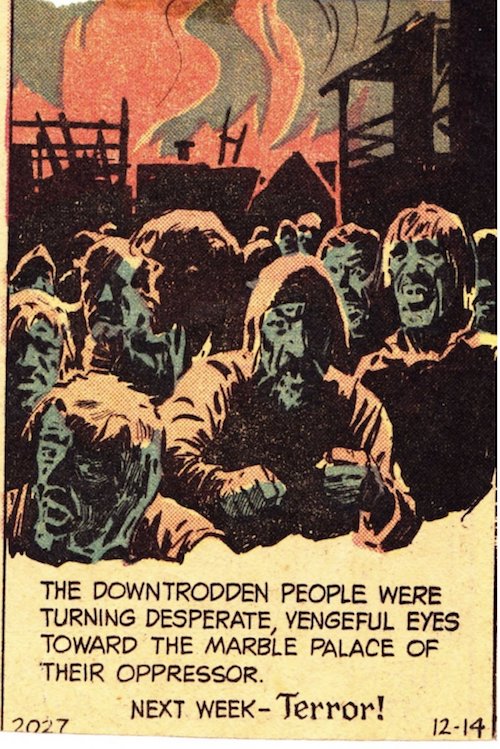

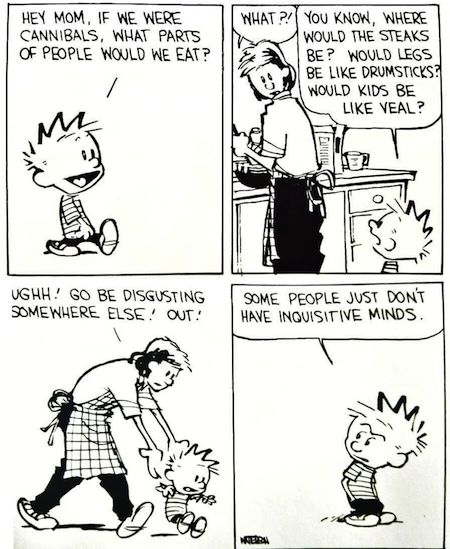

Support the Automatic Earth in virustime.







